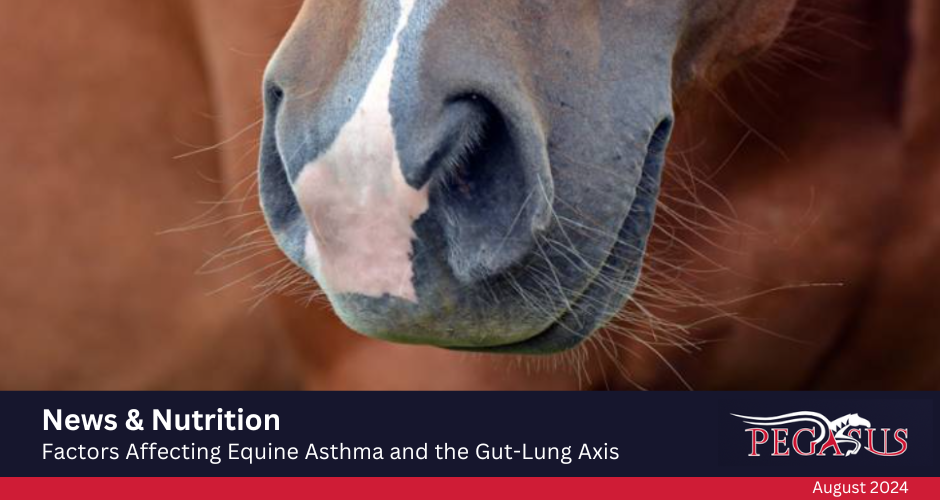
Pegasus News & Nutrition
Factors Affecting Equine Asthma and the Gut-Lung Axis
Equine asthma negatively affects athletic performance and, in severe cases, seriously compromises quality of life. Despite this knowledge, there is much still to learn about this inflammatory airway condition. For example, scientists do not understand how equine asthma develops at a cellular level and what powers its persistence.
“In some horses aerosolized antigens from the environment, such as fungi, endotoxins, mites, and inorganic dust, play a key role in the development of airway inflammation and asthma exacerbation. Those horses show inflammation in bronchoalveolar lavage fluid and respond favorably to allergen avoidance such as soaking or steaming hay to remove dust,” explained Ashley Fowler, Ph.D., a nutritionist with Kentucky Equine Research.
If soaking or steaming hay is not an option, alternative forages including pasture, haylage, and soaked hay cubes or pellets can be fed.
“Haylage is not as common in the United States as it is in Europe and other countries, but researchers have demonstrated that it has significantly lower respirable dust particles resulting in reduced lung inflammation compared to dry hay. If provided as the sole forage source, forage cubes or pellets should be given in multiple meals throughout the day to increase the amount of time spent eating to reduce the amount of time the stomach is empty,” advised Fowler.
According to a recent review on equine asthma, several factors aside from inhaled antigens may contribute to improving or worsening equine asthma.* Some of those include the following:
Lung microbiome. Just like the gastrointestinal tract, the respiratory tract possesses a microbiome—the collection of microorganisms that reside within the horse’s airways. These populations can be further divided into the tracheal and pulmonary (upper and lower airway) microbiomes. The researchers explained a hypothesis in which bacteria migrate between the upper and lower airways, and play a role in regulating the immune system, preventing the spread of respiratory pathogens, and maintaining a healthy lung environment.
“Equine asthma may be associated with airway dysbiosis, where the type and number of bacteria in the respiratory microbiome become altered,” explained Fowler.
Obesity. “Adipose (fat) tissue produces the hormone leptin that stimulates an inflammatory response, and studies suggest that obesity is a risk factor for asthma in humans,” Fowler said.
Obesity may also make it more difficult to control asthma as one study found that obese human patients had a decreased likelihood of achieving asthma control with fluticasone (an inhaled corticosteroid) compared to lean patients.
Diet, intestinal microbiome, and gut-lung crosstalk. Diets high in nonstructural carbohydrates (starches) and low in soluble fiber can alter the intestinal microbiome. In turn, the short-chain fatty acids (SCFAs) produced by the bacteria in the microbiome that have anti-inflammatory and immunomodulatory properties (affecting the immune system’s response to stimuli) are also negatively affected.
“When SCFA-producing bacteria are reduced, the effects are far-reaching and may influence airway health,” Fowler explained.
This is due to the perceived existence of a “gut-lung axis” in which metabolites such as SCFAs contribute to dysregulation of the inflammation in the lungs, and potentially adding to the risk of asthma.
“Host-microbe interactions can extend beyond their local environments and influence immunological response in remote organs,” wrote the researchers. “The gut-lung axis concept is supported by complex connections and intricate pathways involving both the gut and lung microbiota. As of now, most recognized pathways are in the gut-to-lung direction.”
Exercise. In addition to directly contributing to obesity and therefore asthma, as suggested above, lack of exercise has also been associated with worsened asthma control even in nonobese human patients.
“In sum, this review article highlights several factors that should be considered when managing horses with equine asthma: diet, obesity, and exercise. The link between these items and equine asthma could be explained by the gut-lung axis. More research in this field is needed to further characterize the crosstalk between the gut and the lungs. Then, techniques could be developed to manipulate the gut to treat asthma,” summarized Fowler.
“The long-chain omega-3 fatty acids DHA and EPA, as found in EO-3, produce anti-inflammatory molecules that can help reduce the inflammatory environment observed in asthma. Supplementing asthmatic horses with these fatty acids is more effective than providing short-chain omega-3 fatty acids found in flax or camelina oil,” advised Fowler.
*Leduc, L., M. Costa, and M. Leclère. The microbiota and equine asthma: An integrative view of the gut-lung axis. Animals (Basel) 14(2):253.












